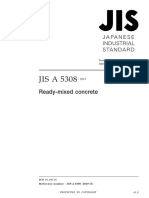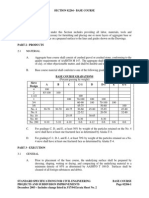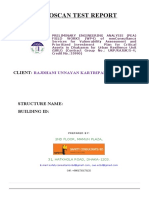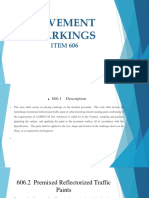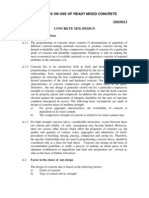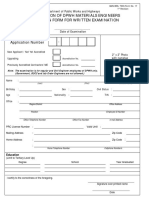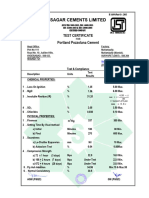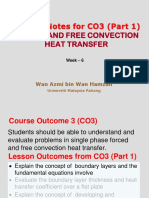Aashto T-97-10
Aashto T-97-10
Uploaded by
Roberto VasquezCopyright:
Available Formats
Aashto T-97-10
Aashto T-97-10
Uploaded by
Roberto VasquezOriginal Description:
Original Title
Copyright
Available Formats
Share this document
Did you find this document useful?
Is this content inappropriate?
Report this DocumentCopyright:
Available Formats
Aashto T-97-10
Aashto T-97-10
Uploaded by
Roberto VasquezCopyright:
Available Formats
Standard Method of Test for
Flexura! Strength of Concrete (Using Simple
Beam with Third-Point Loading)
AASHTO Designation: T 97-10 (ÍHÍI
ASTM Designation: C 78-08
T7~ SCOPE ~
1.1. This test method covers determination of the flexural strength of concrete by the use of a simple
beam with third-point loading.
1.2. The valúes stated in SI units are to be regarded as the standard.
Note 1—For methods of molding concrete specimens, see T 23 and R 39.
1.3. This standard does not purport to address all ofthe safety concerns, ifany, associated with its use.
It ís the responsíbility ofthe user ofthis standard to establish appropriate safeíy and health
practices and determine the applicability of regulatory Umitations prior to use.
~2. REFERENCED DOCUMENTS
2.1. AASHTO Standards:
• R 39, Making and Curing Concrete Test Specimens in the Laboratory
• T 23, Making and Curing Concrete Test Specimens in the Field
• T 24M/T 24, Obtaining and Testing Drilled Cores and Sawed Beams of Concrete
• T 231, Capping Cylindrical Concrete Specimens
2.2. ASTM Standards:
• C 31/C 31M, Standard Practice for Making and Curing Concrete Test Specimens in the Field
• C 42/C 42M, Standard Test Metbod for Obtaining and Testing Drilled Cores and Sawed
Beams of Concrete
• C 192/C 192M, Standard Practice for Making and Curing Concrete Test Specimens in the
Laboratory
• C 617, Standard Practice for Capping Cylindrical Concrete Specimens
• C 1077, Standard Practice for Agencies Testing Concrete and Concrete Aggregates for Use in
Construction and Gritería for Testing Agency Evaluation
• E 4, Standard Practices for Forcé Verification of Testing Machines
3. SIGN1FICANCE AND USE
3.1. This test method is used to determine the flexural strength of specimens prepared and curcd in
accordance with T 23, T 24M/T 24, or R 39. Results are calculated and reported as the modufus of
TS-3c T 97-1 AASHTO
rupture. The strength determined will vary where there are differences in specimen size,
preparatíon, moisture condition, curing, or where the beam has been molded or sawed to size.
3.2. The resuit of this test method may be used to determine compliance with specifications or as a
basis for proportioning, míxing, and placement operations. Tt is used in testíng concrete for
constmction of slabs and pavements.
4. APPARATUS
4.1. The testing machine shall conform to the requirements of sections on Basis of Verifícations,
Corrections, and Time Interval Bctween Vcrifícation of ASTM E 4. Hand-operated testing
machines having pumps that do not provide a continuous loading in one stroke are not permitted.
Motorized pumps or hand-operated positive displacement pumps having sufficient volume in one
continuous stroke to complete a test withont requiring replenishment are permitted and shall be
capable of applying loads at a uniform rate without shock or interruption.
4.2. Loading Apparatus—The third-point loading method shall be used in rnaking ilexure tests of
concrete employing bearing blocks, which will ensure that forces applied to the beam will be
perpendicular lo the face of the specimen and appíied without eccentricity. A diagram of an
apparatus that accomplishes this purpose is shown in Figure 1.
Head of
Testing Machine
Optional Positionsfor
One Steel Rod and
One Steel Ball
Steel Bail
1 in. min —I I— 1 in. min
Load-applying
and Support Blocks
Steel Ball
U^K
Steel Rodd — ^T 7 Rigid Loading Structure or,
if it is a loading accessory,
C i Steel Píate or Channel
Bed of
e
Testing Machine
<_J • L<3
Figure 1—Diagrammatic View of a Suitable Apparatus for Flexure Test of Concrete by Third-Point Loading
Method
4.2.1. All apparatus for making flexiire tests of concrete should be capable of maintaining the specifíed
span length and distances between load-applying blocks and support blocks constant within
±1.3 mm (±0.05 in.).
TS-3c T97-2 AASHTO
4.2.2. The ralio of Ihe horizonlal dislance belween Ihe poinl of application ol'lhe load and Ihe poinl of
application of the nearesl reaction to Ihe deplh of Ihe beam shall be 1.0 ±0.03.
4.2.3. If an apparalus similar lo tlial illustraled in Figure 1 is used:
4.2.3.1. The load-applying and suppoit blocks should not be more llian 64 mm (2/2 in.) high, measured
from Ihe eenler or Ihe axis of pivot, and should cxtcnd cntirely across or bcyond Ihe fu 11 widlh of
Ihe spceimen. Each ease-hardened bearing surface in conlact with thc spccimen shall not depart
from a plañe by more tlian 0.05 mm (0.002 in.) and should be a portion of a cylínder, the axis of
which is coincidental with eilher Ihe axis of Ihe rod or eenler of the ball, wliichever the block is
pivoled upon. The angle subtended by the curved surface of each block should be at least 45
degrees (0.79 rad).
4.2.3.2. The load-applying and support blocks should be maintaincd in a vertical position and in conlact
with the rod or ball by means of spring-loaded screws that hold thcm in contact with the pivot rod
or ball.
4.2.3.3. The uppermost bearing píate and centerpoinl ball in Figure 1 may be omitted wben a spherically
scatcd bearing block is used, provided onc rod and onc ball are used as pivots for the upper load-
applying blocks.
5. TESTING
5.1. The test spccimen shall contbrm to all rcquirements of T 23, T 24M/T 24, and R 39. Thc specimen
shall havc a test span within 2 perccnt of being three times its dcpth as tcstcd. The sides of the
specimen shall be at ríghl angles with Ihe lop and bottom. All surfaces shall be smooth and free of
scars, ¡ndentations, boles, or inscribed idenlification marks.
li. PROCEDURE
6.1. Flexural tesis of moisl-cured speeimens shall be made as soon as praclical afler removal from
moist storage. Sur face drying of the specimen resulls in a reduction in the measured flexura!
strength.
6.2. When using molded speeimens, turn thc test specimen on ils side with respcct to its posilion as
molded and center it on the support bloeks. When using sawcd speeimens, position thc spccimen
so the tensión face corrcsponds to the top or bottom of thc specimen as cut from thc parent
material.
6.3. Center the loading system in relation to Ihe applied torce. Bring the load-applying blocks in
contact with the surface of the specimen at the third points and apply a load of belween 3 and 6
perccnt of the estimatcd ultímate load.
6.4. Using O.lO-mm (0.004-in.) and 0.38-mm (0.015-in.) leaf-typc fcclcr gaugcs, determine whether
any gap belween the spccimen and the load-applying or support blocks is greater or lesser Ihan
each oi'thc gauges ovcr a length of 25 mm (1 in.) or more. Grind, cap, or use Icathcr shims on Ihe
specimen conlact surface lo elimínale any gap in excess of 0.10 mm (0.004 in.) in widlh. Lcather
shims shall be of uniform 6.4 mm (0.25 in.) Ihickness, 25 lo 50 mm (1 to 2 in.) width, and shall
extend aeross Ihe full widlh of Ihe specimen. Gaps in excess of 0.38 mm (0.015 in.) shall be
eliminalcd only by capping or grinding. Grinding of lateral surfaces should be minimized in as
much as grinding may cliange the physical cliaraclerislics ol'lhe speeimens. Capping shall be in
accordance with T 23 1.
TS-3c T 97-3 AASHTO
6.5. Load the specimen continuously and without shock. The load shall be applied at a constant rate to
íhe breaking point. Apply a load at a rate that constantly increases the máximum stress on the
tensión face between 0.9 and 1.2 MPa/min (125 and 175 psi), until mpture occurs. The loading
rate is calculated using the following cquation:
r - Sbd2/L (1)
where:
r = loading rate, MN/min (Ib/min);
S = rate of increase ín extreme fiber stress, MPa/mín (psi/min);
b = average width of specimen mm (in.);
d = average depth of specimen mm (in.); and
L = span length, mm (Ín.).
~1. MEASUREMENT OF SPECIMENS AFTER TEST ———
7.1. To determine the dimensions of the specimen cross section for use in calculating modulus of
rupture, take measurements across one of íhe fraclured faces after testing. The width and depth are
measured with the specimen as oriented for testing. For each dimensión, take one measurement at
each edge and one at the center of the cross section. Use the three measurements for each direction
to determine the average width and the average depth. Take all measurements to íhe nearest 1.3
mm (0.05 in.). If the fracture occurs at a capped section, include the cap thickness in the
measurement.
1T CALCULATIONS ~~~
8.1. If the fracture initiates in the tensión surface within the middle third of the span length, calcúlate
the modulus of rupture as follows:
R = Pl/bd2 (2)
where:
R = modulus of rupture, kPa (psi);
P = máximum appfied load índicated by the testing machine, N (Ibf);
/ = span length, mm (in.);
b = average width of specimen mm (in.); and
d — average depth of specimen mm (in.).
Note 2—The weight of the beam is not included in the above calculation.
8.2. If the fracture occurs in the tensión surface outside of the middle third of the span length by not
more Iban 5 percent of the span length, calcúlate the modulus of rupture as follows:
R = ZPa/bd2 (3)
where:
a = average distance between line of fracture and the nearest support measured on the tensión
surface of the beam, mm (in.).
See Note 2.
8.3. If the fracture occurs in the tensión surface outside of the middle third of the span length by more
than 5 percent of the span length, discard the results of the test.
TS-3c T 97-4 AASHTO
9. REPORT
9.1. The reporí shall include the foUowing:
9.1.1. Identification number;
9.1.2. Average width to the nearest I mm (0.05 in.);
9.1.3. Average depth to the nearest ! mm (0.05 in.);
9.1.4. Span length in millimeters (inches);
9.1.5. Máximum applied load in newtons (pounds-forcé);
9.1.6. Modulus of rupture calculated to the nearest 0.05 MPa (5 psi);
9.1.7. Curing history and apparent moisture condition of the specimens at the time of test;
9.1.8. If specimens were capped, ground, or if leather shims were used;
9.1.9. If specimens were sawed or molded and any defects in the specimens; and
9.1.10. Age of specimens.
7o PRECISIÓN AND BIAS
10.1. Precisión—The coeffícient of variation of test results has been observed to be dependenl on the
strength level of the beams. The single operator coeffícient of variation has been found to be 5.7
percent. Therefore, results of two properly conducted tests by the same operator on beams made
from the same batch sample should not differ from each other by more than 16 percent. The
multilaboratory coefficíent of variation has been found to be 7.0 percent. Therefore, results of two
different laboratories on beams made from the same batch sample should not differ from each
other by more than 19 percent.
10.2. Bias—Because Ihere is no accepted standard for determining bias in this test method, no statement
on bias is made.
TS-3c T 97-5 AASHTO
You might also like
- 506r 05 16 Guide To ShotcreteDocument40 pages506r 05 16 Guide To ShotcreteMardoqueo Perez100% (9)
- Kohinoor Case SyudyDocument7 pagesKohinoor Case SyudyNeel Patel75% (4)
- QAPPDocument37 pagesQAPPcnmo1550% (2)
- Problems 2Document3 pagesProblems 2SandeepVermaNo ratings yet
- Design of Foundation Question PaperDocument2 pagesDesign of Foundation Question PaperSourav Sil100% (1)
- Standard Hooks Card-ASTMDocument2 pagesStandard Hooks Card-ASTMAnonymous ANo ratings yet
- Compressive Strength TestDocument6 pagesCompressive Strength TestjejojuNo ratings yet
- 04 - Atterberg Limits of SoilDocument21 pages04 - Atterberg Limits of SoilYuri ValenciaNo ratings yet
- DPWH-QMSF-48 Rev00 Worksheet On Testing of Asphalt CementDocument1 pageDPWH-QMSF-48 Rev00 Worksheet On Testing of Asphalt CementMyrna FielNo ratings yet
- PNS211Document5 pagesPNS211jbcast86No ratings yet
- Sample Method Statement Astm d1194Document6 pagesSample Method Statement Astm d1194Gio ReyesNo ratings yet
- Aashto M 6-13Document5 pagesAashto M 6-13Abu Alhassan A.No ratings yet
- 1.3 Asphalt Overlay On Existing PavementsDocument8 pages1.3 Asphalt Overlay On Existing PavementsNoel Malinao CablindaNo ratings yet
- DESCRIPTION: ITEM 405-Structural ConcreteDocument11 pagesDESCRIPTION: ITEM 405-Structural ConcreteKioNo ratings yet
- Rebar LocatorDocument5 pagesRebar LocatorSajith Chandran ReoNo ratings yet
- Disclosure To Promote The Right To InformationDocument17 pagesDisclosure To Promote The Right To InformationIndira MukherjeeNo ratings yet
- Aashto T-22-90Document2 pagesAashto T-22-90Putu Agus Santosa100% (1)
- NIStructE - Banana Island Building Collapse - Preliminary ReportDocument13 pagesNIStructE - Banana Island Building Collapse - Preliminary ReportEmerald creationsNo ratings yet
- AASHTO T 191-2002 R2006 Density of Soil In-Place by The Sand-Cone MethodDocument6 pagesAASHTO T 191-2002 R2006 Density of Soil In-Place by The Sand-Cone MethodTony ChineseNo ratings yet
- Compressive Strenght of Concrete From 1-28 Day PDFDocument7 pagesCompressive Strenght of Concrete From 1-28 Day PDFartletNo ratings yet
- Aashto T 87-1986 R2004Document4 pagesAashto T 87-1986 R2004Nikolay Drumev0% (1)
- Aashto T 193-93Document6 pagesAashto T 193-93Hafa Lab100% (1)
- JIS A 5308: Ready-Mixed ConcreteDocument7 pagesJIS A 5308: Ready-Mixed ConcreteCharles Kalalo0% (1)
- D2488 - Description and Identification of Soils (Visual-Manual Procedure) PDFDocument11 pagesD2488 - Description and Identification of Soils (Visual-Manual Procedure) PDFNachoNo ratings yet
- Asphalt PavingDocument14 pagesAsphalt Pavingmido_20067581No ratings yet
- Material Engineering ReviewDocument2 pagesMaterial Engineering ReviewKishin AbeloNo ratings yet
- DGCS Volume 5 ExcerptsDocument53 pagesDGCS Volume 5 ExcerptsElla Mae BayonetaNo ratings yet
- Base CourseDocument3 pagesBase Courseprobook450_ehsanNo ratings yet
- Astm D4595-11Document13 pagesAstm D4595-11Sandra LopesNo ratings yet
- Plate Bearing Test Report - Eei - Caticlan Airport Development Project - Construction of Additional Apron - Union Nabas Aklan - 04october2018Document9 pagesPlate Bearing Test Report - Eei - Caticlan Airport Development Project - Construction of Additional Apron - Union Nabas Aklan - 04october2018Joshua John JulioNo ratings yet
- Ferroscan Test Report: ClientDocument7 pagesFerroscan Test Report: ClientSamsul Arafin TuhinNo ratings yet
- Grouted RiprapDocument8 pagesGrouted RiprapEdison G. CaluzaNo ratings yet
- Daywork SchedulesDocument5 pagesDaywork SchedulesAbdul ThurabNo ratings yet
- Preformed Expansion Joint Filler For Concrete (Bituminous Type)Document2 pagesPreformed Expansion Joint Filler For Concrete (Bituminous Type)mjgutierrezperaltaNo ratings yet
- Time of Setting of Hydraulic Cement by Vicat Needle: Standard Test Method ForDocument3 pagesTime of Setting of Hydraulic Cement by Vicat Needle: Standard Test Method ForNazmus SakibNo ratings yet
- PavementDocument11 pagesPavementJus CamungaoNo ratings yet
- M 147Document2 pagesM 147Katerin HernandezNo ratings yet
- CMT Prelim-Reviewer PDFDocument11 pagesCMT Prelim-Reviewer PDFCONFI DENTIALNo ratings yet
- Properties of Asphalt Materials: Variation of Consistency With TemperatureDocument7 pagesProperties of Asphalt Materials: Variation of Consistency With Temperaturetrjirew3No ratings yet
- DO - 21 - s2019 IRI PDFDocument22 pagesDO - 21 - s2019 IRI PDFShan AdriasNo ratings yet
- Mix Design of ConcreteDocument14 pagesMix Design of ConcreteRaju Shetty CjNo ratings yet
- Application of The Static Cone Penetration TestDocument19 pagesApplication of The Static Cone Penetration TestSD100% (1)
- Reviewer Material Quality Control and Hydrology Division (Promotional Exam)Document99 pagesReviewer Material Quality Control and Hydrology Division (Promotional Exam)Pat Hadji AliNo ratings yet
- ACCREDITATION OF DPWH MATERIALS ENGINEERS APPLICATION Form No. 17 PDFDocument2 pagesACCREDITATION OF DPWH MATERIALS ENGINEERS APPLICATION Form No. 17 PDFJOHN KEVINNo ratings yet
- FINENESS OF HYDRAULIC CEMENT - Group - 7Document5 pagesFINENESS OF HYDRAULIC CEMENT - Group - 7K PrinceNo ratings yet
- ASTM C 535 03 Abrasion TestDocument3 pagesASTM C 535 03 Abrasion TestIsmaelMartinezNo ratings yet
- Project Title: Upgrading of 2 KM Road LOCATION: Brgy. Taboc, San Juan, La UnionDocument35 pagesProject Title: Upgrading of 2 KM Road LOCATION: Brgy. Taboc, San Juan, La UnionRA CruzNo ratings yet
- Los Angeles Abrasion Test PDFDocument3 pagesLos Angeles Abrasion Test PDFBarijit 650% (1)
- Rob - Report 41+508 - 01.02.2016Document13 pagesRob - Report 41+508 - 01.02.2016vivekNo ratings yet
- Unit Weight of Aggregate ASTM C 29Document4 pagesUnit Weight of Aggregate ASTM C 29Yasir100% (1)
- Density (Unit Weight), Yield, and Air Content (Gravimetric) of ConcreteDocument4 pagesDensity (Unit Weight), Yield, and Air Content (Gravimetric) of ConcretemickyfelixNo ratings yet
- Conctrete Mix Design With PPC Cement Research PaperDocument18 pagesConctrete Mix Design With PPC Cement Research PaperPARASASRINIVAS100% (2)
- Specific Gravity of Fine Aggregate ASTM C 128Document3 pagesSpecific Gravity of Fine Aggregate ASTM C 128Yasir0% (1)
- No List of Students Msc. Civil Engineering - Pausti 6 Cohort Serial No Reg. No Name Thesis Title Comment/Proposed Supervisor (S)Document4 pagesNo List of Students Msc. Civil Engineering - Pausti 6 Cohort Serial No Reg. No Name Thesis Title Comment/Proposed Supervisor (S)WazalouaNo ratings yet
- Aashto T 248: Reducing Samples of Aggregate To Testing SizeDocument7 pagesAashto T 248: Reducing Samples of Aggregate To Testing Sizecarloooo100% (1)
- ASTM C1017-13 Standard Specification For Chemical Admixtures For Use in Producing Flowing ConcreteDocument9 pagesASTM C1017-13 Standard Specification For Chemical Admixtures For Use in Producing Flowing Concretebenedick barquinNo ratings yet
- RCD 2 - NSCP 2015 Load Provisions and Load Combinations PDFDocument5 pagesRCD 2 - NSCP 2015 Load Provisions and Load Combinations PDFAugosto FraceNo ratings yet
- Flexural Strength of Concrete (Using Simple Beam With Third-Point Loading)Document4 pagesFlexural Strength of Concrete (Using Simple Beam With Third-Point Loading)Chuwaka OlanNo ratings yet
- Flexural Strength ConcreteDocument3 pagesFlexural Strength ConcreteShantanu DuttaNo ratings yet
- Astm C78Document3 pagesAstm C78avrajan100% (3)
- C78 PDFDocument3 pagesC78 PDFNgayxuan NguyenNo ratings yet
- BO1 at 6 HSD UMFQDocument4 pagesBO1 at 6 HSD UMFQFatah FatahNo ratings yet
- Aashto T-99-10Document12 pagesAashto T-99-10Roberto VasquezNo ratings yet
- Aashto T-99-15Document7 pagesAashto T-99-15Roberto VasquezNo ratings yet
- AASHTO T-104 (Año 2007)Document10 pagesAASHTO T-104 (Año 2007)Roberto VasquezNo ratings yet
- AASHTO M-57 (Año 2008)Document2 pagesAASHTO M-57 (Año 2008)Roberto VasquezNo ratings yet
- AASHTO M-45 (Año 2010)Document3 pagesAASHTO M-45 (Año 2010)Roberto VasquezNo ratings yet
- Theory of Structures: Assignment 1Document16 pagesTheory of Structures: Assignment 1Sakshi SharmaNo ratings yet
- Properties of Philippine Woods Amp TimberDocument28 pagesProperties of Philippine Woods Amp TimberDenzel MilitanteNo ratings yet
- Analysis of RatesDocument12 pagesAnalysis of RatesVenkatesha HebbarNo ratings yet
- CTB2310 - Grondmechanica Tentamenbundel 2017-2018Document105 pagesCTB2310 - Grondmechanica Tentamenbundel 2017-2018Pieter MeulendijksNo ratings yet
- Materials: Experimental Analysis of Space Trusses Using Spacers of Concrete With Steel Fiber and Sisal FiberDocument22 pagesMaterials: Experimental Analysis of Space Trusses Using Spacers of Concrete With Steel Fiber and Sisal FiberTrần Minh ThuậnNo ratings yet
- B.O.Q B&R OfficeDocument6 pagesB.O.Q B&R OfficeEngr Nissar KakarNo ratings yet
- Spec en 4G40Z02312P1-05Document23 pagesSpec en 4G40Z02312P1-05Ageng A. PooNo ratings yet
- List of Enlisted Vendors Civil /electrical / Miscellaneous WorksDocument72 pagesList of Enlisted Vendors Civil /electrical / Miscellaneous WorksTushar SharmaNo ratings yet
- ME130 2 Assignment 5 LUGODocument11 pagesME130 2 Assignment 5 LUGOMatthew MangubatNo ratings yet
- Eacsb PDFDocument297 pagesEacsb PDFTai ThomasNo ratings yet
- ServiceabilityDocument5 pagesServiceabilityAshwin B S RaoNo ratings yet
- PC Wire Strand PDFDocument10 pagesPC Wire Strand PDFruby100% (1)
- NPCP Chapter 5Document2 pagesNPCP Chapter 5Cleo BuendichoNo ratings yet
- Stairwell Pressurization Calculation: Min Press. Difference Stair & Building at Bottom of StairDocument4 pagesStairwell Pressurization Calculation: Min Press. Difference Stair & Building at Bottom of StairFarzin ShahabNo ratings yet
- B-36.021 - Rev A-HVAC Cooling Load Calculation Report-Ground FloorDocument11 pagesB-36.021 - Rev A-HVAC Cooling Load Calculation Report-Ground Floorchukudi oguneNo ratings yet
- PPC - MTCDocument1 pagePPC - MTCNaresh KumarNo ratings yet
- Seismic Design Criteria For R.C. Structures in Saudi ArabiaDocument9 pagesSeismic Design Criteria For R.C. Structures in Saudi ArabiaAngelo Sanghoon HAN100% (1)
- Schedule ADocument13 pagesSchedule AAnonymous eKt1FCDNo ratings yet
- Renovation QuotationDocument1 pageRenovation Quotationdubai eyeNo ratings yet
- 97 0004 PDFDocument306 pages97 0004 PDFabadittadesseNo ratings yet
- Non Load Bearing Gypsum BoardsDocument13 pagesNon Load Bearing Gypsum Boardssaahasitha 14No ratings yet
- Preparation of Shrinkage Compensating Concrete WitDocument7 pagesPreparation of Shrinkage Compensating Concrete WitPradeep VempadaNo ratings yet
- Construction Issues: Anchoring MEP Items Into Suspended SlabsDocument2 pagesConstruction Issues: Anchoring MEP Items Into Suspended SlabsMario SandovalNo ratings yet
- SES ScrubberDocument3 pagesSES ScrubberChengkc2014No ratings yet
- Part 2 - Continued Spread Footings & ExamplesDocument15 pagesPart 2 - Continued Spread Footings & Examplesاسومي الوكحNo ratings yet
- Lecture Notes For CO3 (Part 1) : Forced and Free Convection Heat TransferDocument43 pagesLecture Notes For CO3 (Part 1) : Forced and Free Convection Heat TransferSarindran RamayesNo ratings yet






















